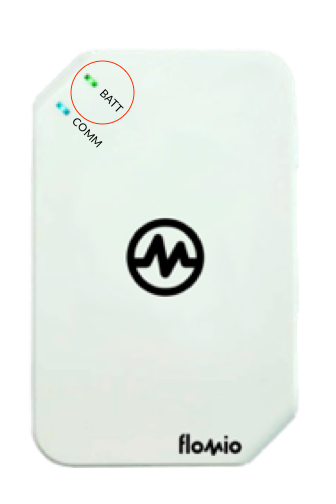Continuous Scanning With FloBLE (ACR1255U-J1)

FloBLE Plus power probe
Customers have reported that FloBLE readers are losing connection while operating for long stretches. We thought this could be because batteries were draining out so we studied the overall power performance of the FloBLE Plus (ACR1255U-J1) in detail. Ultimately, we wanted to know if a standard USB port (USB1.0 from PC) would enough to keep a FloBLE connected and scanning continuously. TL;DR: Yes! like the FloJack (ACR35), the FloBLE (ACR1255U-J1) is capable of continuously scanning NFC tags while powered by a standard USB port from a PC or wall adapter.
The main question is if a USB port can charge the FloBLE/ACR1255U-J1 battery faster than it’s being discharged while polling for tags. To answer this it’s important to see how the battery is functioning over time. By looking at the current drawn from the battery as well as delivered by the charger and comparing that to both the ratings of the battery and the power supply, we’ll know if the supply can keep up with the load. We’ll use the lowest power supply option which is a standard USB port on a PC.
Equipment
The FloBLE/ACR1255u-J1 pulses a magnetic field to detect NFC tags. Currents during the time the field is active are significantly higher than times when it’s inactive. We’ll use an oscilloscope to capture the power fluctuations being supplied by the battery during these operations.
We’ll need a shunt circuit to transduce the battery current into a bipolar voltage that represents the magnitude and direction of the current flowing through the battery. We’ll record this voltage along with the battery voltage to understand the battery function. The circuit will need to allow the test battery to still power the reader. Lastly, we’ll use a current production unit of FloBLE Plus/ACR1255U-J1 along with by version 2.2 (11) of the Flomio Test App on an iPad.
The sketch here is the shunt circuit. It has an amplifier with a filtered shunt resistor in series with the battery and a reference voltage to bias the amplifier output to a midpoint voltage so that current can be observed into and out of the battery.
The fixed gain of the amp and resistor value result in an output of 1.25 V/Amp
We built the circuit on a bare PCB so as to attach the battery to the shunt while connected via a cable to the reader. This circuit is interchangeable with a variety of our readers for consistent battery testing.
Testing FloBLE/ACR1255U-J1
We attached the oscilloscope to TP2 with the ground lead tied to the reference voltage at TP3. The output of the circuit while the FloBLE Plus/ACR1255U-J1 was polling for tags and NOT connected to a USB supply is shown here. You can see the battery supplying a steady current of 12ma and a pulse of 150ma with a width of 13.2 ms every 500ms. Note that the current out of the battery is positive and we had to calibrate out a slight offset in the circuit to get these results.
The battery has a capacity of 320 mAh. Integrating the current for a complete 500ms cycle and solving for the RMS current results in a drain on the battery of 16ma RMS, which is several orders of magnitude lower than the ratings of USB port supply (500mA).
This means the battery will supply the reader polling continuously for nearly 20 hours without being connected to a charger. Additionally, a standard USB 1.0/2.0 port can supply the remaining 484 ma of current to charge the battery. Note that the reader IS NOT scanning tags, when it does the current remains at the peak current of the pulse while the card is present. While high at 150ma the standard USB 1.0/2.0 port would still be able to supply the reader with enough power for the NFC field AND still be able to charge the battery.
Furthermore, we allowed the battery to discharge to a low level and then connected the reader to a standard USB 1.0/2.0 port. The resulting plot illustrates the reader staying in the charging mode (positive voltage) while still charging the battery.
The unusual surge in charging current immediately after the NFC pulse is most likely a capacitor bank recharging after being discharged during the pulse. The charging current being delivered to the battery is approximately 235ma when not pulsing. This current is a function of how deeply discharged the battery is and tails off as the battery approaches full charge. It appears that the charging circuit in the reader is limiting the current applied to the battery and is not being limited by the USB supply current.
Observations
The FloBLE Plus/ACR1255U-J1 was left connected to a USB port and tested while polling for tags continuously and recording the battery voltage for a full day. Below is the full capture across the 17hrs and 10mins of testing. In this plot the battery voltage varies slightly between 4.164V and 4.200V. Note that the voltage was scaled with a divider to allow for a more compressed voltage range (0 to +/- 4V) on the oscilloscope. The actual battery voltage is Vplot x 2.13:
The voltages are far from the discharged battery (<3.7V) voltage and show the reader cycling between charging and discharging about once per hour. During charging the current draw is low, approximately 50ma and well below the capacity of the USB port.
The plot here shows typical charge cycles of the reader during continuous scanning for NFC tags. These currents are typically seen while the battery indicator LED is red. The LED is seen to cycle on and off with the charging cycle.
Note that the USB port supplies enough current for the field pulse and battery charging at the same time. There is no current flowing out of the battery (positive voltage) the current continues to flow into the battery even during the pulse.
As a final test, we fully charged a FloBLE Plus (ACR1255U-J1) and connected to the Flomio Test app set to scan continuously. We then observed the reader’s behavior until the battery discharged to the point that the system stopped functioning.  The battery lasted 19 hours and 42 minutes before the Test app reported the reader was disconnected. About 1 hour before the reader disconnected the battery LED flashed red and the Test App indicated the battery had 10% of charge remaining. The following screenshot shows the battery discharge curve. The battery transitions from functional to non functional very rapidly as seen by the abrupt “knee” in the discharge curve during the last hour of operation. When connecting to power after being discharged, the reader and app reconnected as expected and scanning resumed normally. The battery then recharged fully while continuously scanning in about 1 hour (note there is a delay between discharge and the reconnection to the USB port).
The battery lasted 19 hours and 42 minutes before the Test app reported the reader was disconnected. About 1 hour before the reader disconnected the battery LED flashed red and the Test App indicated the battery had 10% of charge remaining. The following screenshot shows the battery discharge curve. The battery transitions from functional to non functional very rapidly as seen by the abrupt “knee” in the discharge curve during the last hour of operation. When connecting to power after being discharged, the reader and app reconnected as expected and scanning resumed normally. The battery then recharged fully while continuously scanning in about 1 hour (note there is a delay between discharge and the reconnection to the USB port).
Conclusion
The test results showed that the FloBLE Plus/ACR1255U-J1 reader draws on average 16ma while polling continuously for tags. Computer USB 1.0/2.0 ports can supply up to 500ma and USB 3.0 900ma which is well above what the reader requires. The reader’s battery stays nearly fully charged while connected to a USB 2.0 port while polling. The reader employs a shallow discharge and recharge cycle rather than a trickle charge strategy to keep the battery fully charged. With a tag in the field the reader will draw a continuous 150ma and would still be able to charge the battery if connected to a USB 2.0 port indefinitely. With a fully discharged battery the reader is capable of operating normally connected to a USB port and polling and still able to recharge the battery.
Therefore, intermittent problems reported by customers are more likely due to data communication problems than to resets caused by discharged batteries.
– Jim Disser











Leave a Reply
Want to join the discussion?Feel free to contribute!